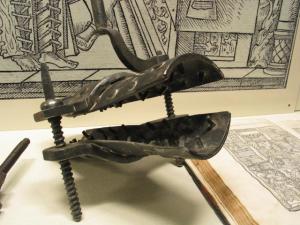

Years ago I visited the Criminal Museum in picturesque Rothenberg, Germany. This unique place was my introduction to the cruel world of my peasant ancestors. Typical Americans who tour Europe visit royal palaces and grand museums unaware that these ostentatious sites likely are not part of most peoples’ heritage. Relatively few royals immigrated to America. Most of us descended from the persecuted peasant class.
The Criminal Museum displayed hundreds of fascinating punishment devices used in medieval times. I recall a heavy wooden rosary that had to be worn for missing Sunday mass. There was metal contraption (shown below) resembling a flute that was secured around the neck and inserted into the mouth. Every breath produced a strident sound announcing that the flutist was a disgraceful musician.

The creativity of these brutal devices revealed the perverse nature of torture. Even in the Middle Ages, inventors were striving to be more and more ingenious in perfecting their instruments of punishment. What kind of devious mind delighted in the inventions of The Iron Maiden, dunking stools and thumb screws?
The early prisons weren’t places for the accused to just sit and languish. They were given work to do! The earliest town records of Ipswich describe flax and hemp brought to the prisoners for their “work program.”
Ipswich’s first prison was erected in 1652 right across from the meeting house and was twenty feet long and sixteen feet wide. The first warden was Theophilus Wilson who was paid five shillings per prisoner. There are old records of bills from imprisonment that still exist. The bill “for food and attendance” had to be paid before the prisoner was released. Prisoners who had no resources were given bread and water.
T
The devices and instruments the Puritans used to punish sinners and criminals originated in Europe. It seems strange to describe the Puritan approach as more civil, but they did show some restraint and retained just a few old world “favorites.”
The Bilboes

The first Puritans brought over the bilboes as a way to punish sinners and lawbreakers. It was named after its place of origin, Bilboa, Spain, and was shipped with the Spanish Armada in anticipation of all the English prisoners they would have a need to shackle.
The Bilboes were a simple but effective restraint. The device had a long heavy bolt or bar of iron with two sliding shackles, something like handcuffs, and a lock. The legs of offenders were thrust into the shackles and then locked with a padlock. A chain at one end attached both the bilboes and prisoner to the floor or wall.
In 1629, Thomas Morton erected a Maypole right under the noses of the Pilgrims at Plymouth Colony. Myles Standish led a raiding party, arrested Morton and put him in the bilboes. The pilgrims obviously didn’t appreciate Morton’s intended recreation. Bilboes were eventually replaced with wooden stocks.
Cleft Stick
Slanderers, scolds, and liars were liable to have a cleft stick – a stick split at the end – placed onto their tongues while they stood on display in public. Mild offenses such as whispering during church services could earn the cleft stick. Children in school could also have a cleft stick for their tongues for “ill words or untimely words in school.”
Branding and Maiming
Branding and maiming were common punishments, especially for those accused of being a Quaker. George Bishop gave this account of a fellow Quaker’s punishment.
“The Drum was Beat, the People gather’d, Norton was fetch’d and stripp’d to the Waste, and set with his back to the Magistrates, and given in their view thirty-six cruel stripes with a knotted cord, and his hand made fast in the Stocks where they had set his Body before, and burn’d very deep with a Red-hot Iron with H. for Heresie.”
Puritans preferred to banish the Quakers after meting out the punishments. A male Quaker, for the first offense, would have one of his ears cut off and his other ear cut off for the second. The third offense resulted in having their tongues bored through with a hot iron.
Stocks and Pillories

Stocks and pillories were staples of New England punishment. A stock is simply a wooden board with one or more semicircles cut into one edge. When joined to another stock, the semicircles form holes and become “stocks.” A pillory is a set of stocks with three holes: one for the neck in the center and small holes on each side for the wrists.


Although popular in Europe, there are no records of the use of branks or a dunking stool in colonial America. Branks were an iron cage that went around the head with a spiked plate over the tongue making speaking painful. The dunking stool, a chair that encaged the whole person, was hung from the end of the free moving arm near the side of a river. The dunking could last for a few seconds, or the process could be continuously repeated. Severe crimes such as witchcraft or prostitution warranted the dunking stool, but it was also used with women considered to be gossips or bad-tempered. Bakers who slighted their customers might also justify a dunking.